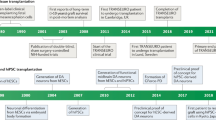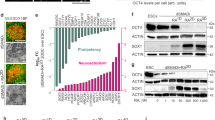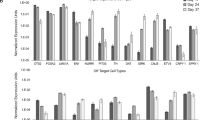Abstract
Parkinson's disease is a widespread condition caused by the loss of midbrain neurons that synthesize the neurotransmitter dopamine. Cells derived from the fetal midbrain can modify the course of the disease, but they are an inadequate source of dopamine-synthesizing neurons because their ability to generate these neurons is unstable. In contrast, embryonic stem (ES) cells proliferate extensively and can generate dopamine neurons. If ES cells are to become the basis for cell therapies, we must develop methods of enriching for the cell of interest and demonstrate that these cells show functions that will assist in treating the disease. Here we show that a highly enriched population of midbrain neural stem cells can be derived from mouse ES cells. The dopamine neurons generated by these stem cells show electrophysiological and behavioural properties expected of neurons from the midbrain. Our results encourage the use of ES cells in cell-replacement therapy for Parkinson's disease.
This is a preview of subscription content, access via your institution
Access options
Subscribe to this journal
Receive 51 print issues and online access
$199.00 per year
only $3.90 per issue
Buy this article
- Purchase on Springer Link
- Instant access to full article PDF
Prices may be subject to local taxes which are calculated during checkout





Similar content being viewed by others
References
Studer, L., Tabar, V. & McKay, R. D. Transplantation of expanded mesencephalic precursors leads to recovery in parkinsonian rats. Nature Neurosci. 1, 290–295 (1998)
Sanchez-Pernaute, R., Studer, L., Bankiewicz, K. S., Major, E. O. & McKay, R. D. In vitro generation and transplantation of precursor-derived human dopamine neurons. J. Neurosci. Res. 65, 284–288 (2001)
Thomson, J. A. et al. Embryonic stem cell lines derived from human blastocysts. Science 282, 1145–1147 (1998)
Shamblott, M. J. et al. Derivation of pluripotent stem cells from cultured human primordial germ cells. Proc. Natl Acad. Sci. USA 95, 13726–13731 (1998)
McDonald, J. W. et al. Transplanted embryonic stem cells survive, differentiate and promote recovery in injured rat spinal cord. Nature Med. 5, 1410–1412 (1999)
Rideout, W. M. III, Hochedlinger, K., Kyba, M., Daley, G. & Jaenisch, R. Correction of a genetic defect by nuclear transplantation and combined cell and gene therapy. Cell 109, 17–27 (2002)
Kyba, M., Perlingeiro, R. C. R. & Daley, G. Q. HoxB4 confers definitive lymphoid–myeloid engraftment potential on embryonic stem cell and yolk sac hematopoietic progenitors. Cell 109, 29–37 (2002)
Lee, S. H., Lumelsky, N., Auerbach, J. M. & McKay, R. D. Efficient generation of midbrain and hindbrain neurons from mouse embryonic stem cells. Nature Biotechnol. 18, 675–679 (2000)
Okabe, S., Forsberg-Nilsson, K., Spiro, A. C., Segal, M. & McKay, R. D. Development of neuronal precursor cells and functional postmitotic neurons from embryonic stem cells in vitro. Mech. Dev. 59, 89–102 (1996)
Wallen, A. et al. Fate of mesencephalic AHD2-expressing dopamine progenitor cells in NURR1 mutant mice. Exp. Cell. Res. 253, 737–746 (1999)
Zetterstrom, R. H. et al. Dopamine neuron agenesis in Nurr1-deficient mice. Science 276, 248–250 (1997)
Saucedo-Cardenas, O. et al. Nurr1 is essential for the induction of the dopaminergic phenotype and the survival of ventral mesencephalic late dopaminergic precursor neurons. Proc. Natl Acad. Sci. USA 95, 4013–4018 (1998)
Le, W. et al. Selective agenesis of mesencephalic dopaminergic neurons in Nurr1-deficient mice. Exp. Neurol. 159, 451–458 (1999)
Lumelsky, N. et al. Differentiation of embryonic stem cells to insulin-secreting structures similar to pancreatic islets. Science 292, 1389–1394 (2001)
Bader, A., Al-Dubai, H. & Weitzer, G. Leukemia inhibitory factor modulates cardiogenesis in embryoid bodies in opposite fashions. Circ. Res. 86, 787–794 (2000)
Molne, M. et al. Early cortical precursors do not undergo LIF-mediated astrocytic differentiation. J. Neurosci. Res. 59, 301–311 (2000)
Offield, M. F. et al. PDX-1 is required for pancreatic outgrowth and differentiation of the rostral duodenum. Development 122, 983–995 (1996)
Hynes, M. & Rosenthal, A. Specification of dopaminergic and serotonergic neurons in the vertebrate CNS. Curr. Opin. Neurobiol. 9, 26–36 (1999)
Wurst, W. & Bally-Cuif, L. Neural plate patterning: upstream and downstream of the isthmic organizer. Nature Rev. Neurosci. 2, 99–108 (2001)
Ye, W., Shimamura, K., Rubenstein, J. L., Hynes, M. A. & Rosenthal, A. FGF and Shh signals control dopaminergic and serotonergic cell fate in the anterior neural plate. Cell 93, 755–766 (1998)
Broccoli, V., Boncinelli, E. & Wurst, W. The caudal limit of Otx2 expression positions the isthmic organizer. Nature 401, 164–168 (1999)
Joyner, A. L., Liu, A. & Millet, S. Otx2, Gbx2 and Fgf8 interact to position and maintain a mid-hindbrain organizer. Curr. Opin. Cell Biol. 12, 736–741 (2000)
Tao, W. & Lai, E. Telencephalon-restricted expression of BF-1, a new member of the HNF-3/fork head gene family, in the developing rat brain. Neuron 8, 957–966 (1992)
Wurst, W., Auerbach, A. B. & Joyner, A. L. Multiple developmental defects in Engrailed-1 mutant mice: an early mid-hindbrain deletion and patterning defects in forelimbs and sternum. Development 120, 2065–2075 (1994)
Smidt, M. P. et al. A second independent pathway for development of mesencephalic dopaminergic neurons requires Lmx1b. Nature Neurosci. 3, 337–341 (2000)
Gerfen, C. R., Baimbridge, K. G. & Thibault, J. The neostriatal mosaic: III. Biochemical and developmental dissociation of patch-matrix mesostriatal systems. J. Neurosci. 7, 3935–3944 (1987)
Reyport, S. et al. Identified postnatal mesolimbic dopamine neurons in culture; morphology and electrophysiology. J. Neurosci. 12, 4264–4280 (1992)
Rohrbacher, J., Ichinohe, N. & Kitai, S. T. Electrophysiological characteristics of substantia nigra neurons in organotypic cultures: spontaneous and evoked activities. Neuroscience 97, 703–714 (2000)
Fiorillo, C. D. & Williams, J. T. Glutamate mediates an inhibitory postsynaptic potential in dopamine neurons. Nature 394, 78–82 (1998)
Abrous, D. N., Shaltot, A. R., Torres, E. M. & Dunnett, S. B. Dopamine-rich grafts in the neostriatum and/or nucleus accumbens: effects on drug-induced behaviours and skilled paw-reaching. Neuroscience 53, 187–197 (1993)
Nikkhah, G., Duan, W. M., Knappe, U., Jödicke, A. & Björklund, A. Restoration of complex sensorimotor behaviour and skilled forelimb use by a modified nigral cell suspension transplantation approach in the rat Parkinson model. Neuroscience 56, 33–43 (1993)
Zuddas, A., Corsini, G. U., Barker, J. L., Kopin, I. J. & di Porzio, U. Specific reinnervation of lesioned mouse striatum by grafted mesencephalic dopaminergic neurons. Eur. J. Neurosci. 3, 77–85 (1991)
Hudson, J. L., Bickford, P., Johansson, M., Hoffer, B. J. & Stromberg, I. Target and neurotransmitter specificity of fetal central nervous system transplants: importance for functional reinnervation. J. Neurosci. 14, 283–290 (1994)
Björklund, A. & Lindvall, O. Cell replacement therapies for central nervous system disorders. Nature Neurosci. 3, 537–544 (2000)
Björklund, L. M. et al. Embryonic stem cells develop into functional dopaminergic neurons after transplantation in a Parkinson rat model. Proc. Natl Acad. Sci. USA 99, 2344–2349 (2002)
Gross, C. et al. Serotonin1A receptor acts during development to establish normal anxiety-like behaviour in the adult. Nature 416, 396–400 (2002)
Sawa, A. & Snyder, S. H. Schizophrenia: diverse approaches to a complex disease. Science 296, 692–695 (2002)
Mallamaci, A., Di Blas, E., Briata, P., Boncinelli, E. & Corte, G. OTX2 homeoprotein in the developing central nervous system and migratory cells of the olfactory area. Mech. Dev. 58, 165–178 (1996)
Le, W. L., Conneely, O. M., He, Y., Jankovic, J. & Appel, S. H. Reduced Nurr1 expression increases the vulnerability of mesencephalic dopamine neurons to MPTP-induced injury. J. Neurochem. 73, 2218–2221 (1999)
Auerbach, J. M., Eiden, M. V. & McKay, R. D. Transplanted CNS stem cells form functional synapses in vivo. Eur. J. Neurosci. 12, 1696–1704 (2000)
Olsson, M., Nikkhah, G., Bentlage, C. & Björklund, A. Forelimb akinesia in the rat Parkinson model: Differential effects of dopamine agonists and nigral transplants as assessed by a new stepping test. J. Neurosci. 15, 3863–3875 (1995)
Montoya, C. P., Campbell, H. L., Pemberton, K. D. & Dunnett, S. B. The ‘staircase test’: a measure of independent forelimb reaching and grasping abilities in rats. J. Neurosci. Methods 36, 219–228 (1991)
Schallert, T., Fleming, S. M., Leasure, J. L., Tillerson, J. L. & Bland, S. T. CNS plasticity and assessment of forelimb sensorimotor outcome in unilateral rat models of stroke, cortical ablation, parkinsonism and spinal cord injury. Neuropharmacology 39, 777–787 (2000)
Acknowledgements
We thank J. Harvey-White for technical assistance with HPLC, P. Brasted for advice on the non-pharmacological evaluation of the grafted animals, and J. Kordower for supplying boxes for the paw-reaching test, E. Lai for the anti-bB1 antibody and G. Corte for the anti-OTX2 antibody. We thank D. Owens for critical discussion of the manuscript. J.A.R.-G. was supported by a postdoctoral fellowship from the Spanish Ministerio de Educación, Cultura y Deporte. I.V. is a Pew Latin American fellow. We thank the National Parkinson Foundation and the Tuchman Foundation for their support.
Author information
Authors and Affiliations
Corresponding author
Ethics declarations
Competing interests
The authors declare that they have no competing financial interests.
Rights and permissions
About this article
Cite this article
Kim, JH., Auerbach, J., Rodríguez-Gómez, J. et al. Dopamine neurons derived from embryonic stem cells function in an animal model of Parkinson's disease. Nature 418, 50–56 (2002). https://doi.org/10.1038/nature00900
Received:
Accepted:
Published:
Issue Date:
DOI: https://doi.org/10.1038/nature00900
This article is cited by
-
Bi-directional regulation of AIMP2 and its splice variant on PARP-1-dependent neuronal cell death; Therapeutic implication for Parkinson's disease
Acta Neuropathologica Communications (2024)
-
Three Dimensional Bioprinting for Hepatic Tissue Engineering: From In Vitro Models to Clinical Applications
Tissue Engineering and Regenerative Medicine (2024)
-
Functional nanoparticle-enabled non-genetic neuromodulation
Journal of Nanobiotechnology (2023)
-
Conjugated polymer nanoparticles and their nanohybrids as smart photoluminescent and photoresponsive material for biosensing, imaging, and theranostics
Microchimica Acta (2022)
-
Mouse Pluripotent Stem Cell Differentiation Under Physiological Oxygen Reduces Residual Teratomas
Cellular and Molecular Bioengineering (2021)
Comments
By submitting a comment you agree to abide by our Terms and Community Guidelines. If you find something abusive or that does not comply with our terms or guidelines please flag it as inappropriate.



